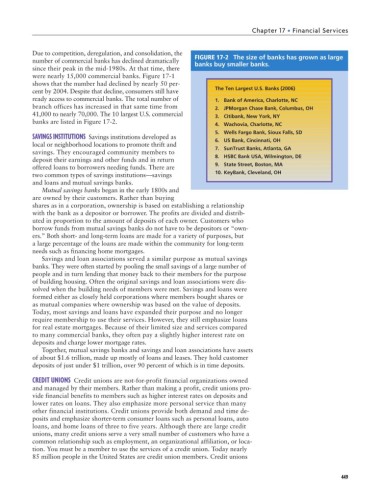Page 462 - Business Principles and Management
P. 462
Chapter 17 • Financial Services
Due to competition, deregulation, and consolidation, the
number of commercial banks has declined dramatically FIGURE 17-2 The size of banks has grown as large
banks buy smaller banks.
since their peak in the mid-1980s. At that time, there
were nearly 15,000 commercial banks. Figure 17-1
shows that the number had declined by nearly 50 per-
cent by 2004. Despite that decline, consumers still have The Ten Largest U.S. Banks (2006)
ready access to commercial banks. The total number of 1. Bank of America, Charlotte, NC
branch offices has increased in that same time from 2. JPMorgan Chase Bank, Columbus, OH
41,000 to nearly 70,000. The 10 largest U.S. commercial 3. Citibank, New York, NY
banks are listed in Figure 17-2.
4. Wachovia, Charlotte, NC
5. Wells Fargo Bank, Sioux Falls, SD
SAVINGS INSTITUTIONS Savings institutions developed as 6. US Bank, Cincinnati, OH
local or neighborhood locations to promote thrift and
savings. They encouraged community members to 7. SunTrust Banks, Atlanta, GA
deposit their earnings and other funds and in return 8. HSBC Bank USA, Wilmington, DE
offered loans to borrowers needing funds. There are 9. State Street, Boston, MA
two common types of savings institutions—savings 10. KeyBank, Cleveland, OH
and loans and mutual savings banks.
Mutual savings banks began in the early 1800s and
are owned by their customers. Rather than buying
shares as in a corporation, ownership is based on establishing a relationship
with the bank as a depositor or borrower. The profits are divided and distrib-
uted in proportion to the amount of deposits of each owner. Customers who
borrow funds from mutual savings banks do not have to be depositors or “own-
ers.” Both short- and long-term loans are made for a variety of purposes, but
a large percentage of the loans are made within the community for long-term
needs such as financing home mortgages.
Savings and loan associations served a similar purpose as mutual savings
banks. They were often started by pooling the small savings of a large number of
people and in turn lending that money back to their members for the purpose
of building housing. Often the original savings and loan associations were dis-
solved when the building needs of members were met. Savings and loans were
formed either as closely held corporations where members bought shares or
as mutual companies where ownership was based on the value of deposits.
Today, most savings and loans have expanded their purpose and no longer
require membership to use their services. However, they still emphasize loans
for real estate mortgages. Because of their limited size and services compared
to many commercial banks, they often pay a slightly higher interest rate on
deposits and charge lower mortgage rates.
Together, mutual savings banks and savings and loan associations have assets
of about $1.6 trillion, made up mostly of loans and leases. They hold customer
deposits of just under $1 trillion, over 90 percent of which is in time deposits.
CREDIT UNIONS Credit unions are not-for-profit financial organizations owned
and managed by their members. Rather than making a profit, credit unions pro-
vide financial benefits to members such as higher interest rates on deposits and
lower rates on loans. They also emphasize more personal service than many
other financial institutions. Credit unions provide both demand and time de-
posits and emphasize shorter-term consumer loans such as personal loans, auto
loans, and home loans of three to five years. Although there are large credit
unions, many credit unions serve a very small number of customers who have a
common relationship such as employment, an organizational affiliation, or loca-
tion. You must be a member to use the services of a credit union. Today nearly
85 million people in the United States are credit union members. Credit unions
449

